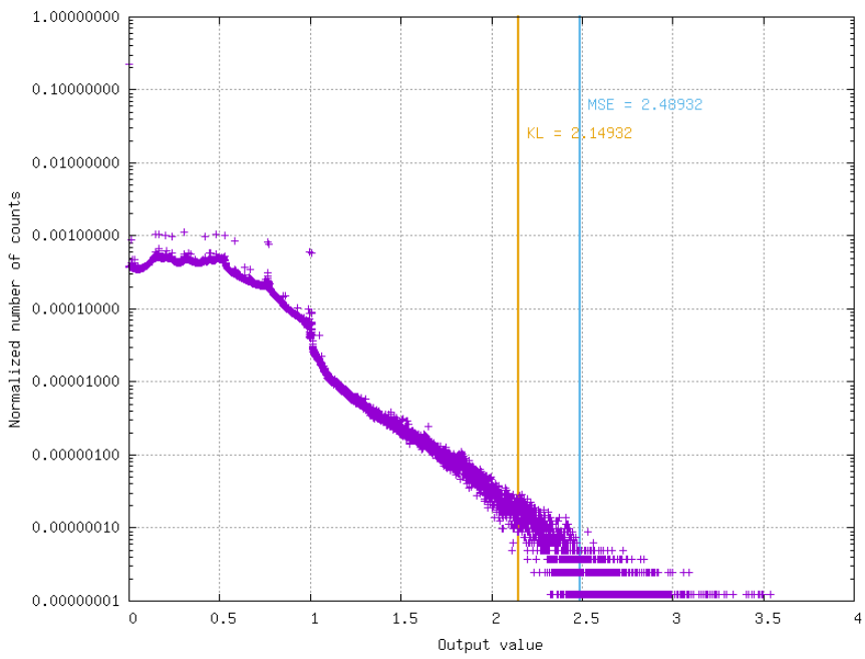Post-training quantization¶
Principle¶
The post-training quantization algorithm is done in 3 steps:
1) Weights normalization¶
All weights are rescaled in the range \([-1.0, 1.0]\).
- Per layer normalization
There is a single weights scaling factor, global to the layer.
- Per layer and per output channel normalization
There is a different weights scaling factor for each output channel. This allows a finer grain quantization, with a better usage of the quantized range for some output channels, at the expense of more factors to be saved in memory.
2) Activations normalization¶
Activations at each layer are rescaled in the range \([-1.0, 1.0]\) for signed outputs and \([0.0, 1.0]\) for unsigned outputs.
The optimal quantization threshold value of the activation output of each layer is determined using the validation dataset (or test dataset if no validation dataset is available).
This is an iterative process: need to take into account previous layers normalizing factors.
Finding the optimal quantization threshold value of the activation output of each layer is done the following:
Compute histogram of activation values;
Find threshold that minimizes distance between original distribution and clipped quantized distribution. Two distance algorithms can be used:
Mean Squared Error (MSE);
Kullback–Leibler divergence metric (KL-divergence).
Another, simpler method, is to just clip the values above a fixed quantile.

The obtained threshold value is therefore the activation scaling factor to be taken into account during quantization.
3) Quantization¶
Inputs, weights, biases and activations are quantized to the desired \(nbbits\) precision.
Convert ranges from \([-1.0, 1.0]\) and \([0.0, 1.0]\) to \([-2^{nbbits-1}-1, 2^{nbbits-1}-1]\) and \([0, 2^{nbbits}-1]\) taking into account all dependencies.
Additional optimization strategies¶
Weights clipping (optional)¶
Weights can be clipped using the same strategy than for the activations ( finding the optimal quantization threshold using the weights histogram). However, this usually leads to worse results than no clipping.
Activation scaling factor approximation¶
The activation scaling factor \(\alpha\) can be approximated the following ways:
Fixed-point: \(\alpha\) is approximated by \(x 2^{-p}\);
Single-shift: \(\alpha\) is approximated by \(2^{x}\);
Double-shift: \(\alpha\) is approximated by \(2^{n} + 2^{m}\).
Usage in N2D2¶
All the post-training strategies described above are available in N2D2 for any
export type. To apply post-training quantization during export, simply use the
-calib command line argument.
The following parameters are available in command line:
Argument [default value] |
Description |
|---|---|
|
Number of stimuli used for the calibration ( |
|
Reload and reuse the data of a previous calibration |
|
Weights clipping mode on export, can be |
|
Activations clipping mode on export, can be |
|
Activations scaling mode on export, can be |
|
If true (1), rescale activation per output instead of per layer |
|
If activation clipping mode is |
-act-rescaling-mode¶
The -act-rescaling-mode specifies how the activation scaling must be approximated,
for values other than Floating-point. This allows to avoid floating-point
operation altogether in the generated code, even for complex, multi-branches networks.
This is particularly useful on architectures without FPU or on FPGA.
For fixed-point scaling approximation (\(x 2^{-p}\)), two modes are available:
Fixed-point16 and Fixed-point32. Fixed-point16 specifies that \(x\)
must hold in at most 16-bits, whereas Fixed-point32 allows 32-bits \(x\).
In the later case, beware that overflow can occur on 32-bits only architectures
when computing the scaling multiplication before the right shift (\(p\)).
For the Single-shift and Double-shift modes, only right shifts are allowed
(scaling factor < 1.0). In case of layers with scaling factor above 1.0, Fixed-point16
is used as fallback for these layers.
Command line example¶
Command line example to run the C++ Export on a INI file containing an ONNX model:
n2d2 MobileNet_ONNX.ini -seed 1 -w /dev/null -export CPP -fuse -calib -1 -act-clipping-mode KL-Divergence
With the python API¶
- n2d2.quantizer.PTQ(deepnet_cell, nb_bits: int, nb_sitmuli: int = -1, provider: Provider = None, no_unsigned: bool = False, cross_layer_equalization: bool = True, wt_clipping_mode: str = 'NONE', act_clipping_mode: str = 'MSE', act_scaling_mode: str = 'FLOAT_MULT', act_rescale_per_output: bool = False, **kwargs)¶
- Parameters:
nb_bits (int) – Number of bits per weight for exports (can be for example -16 for float 16 bits or 8 int 8 bits)
nb_sitmuli (int, optional) – The number of stimuli used for the calibration (
0= no calibration,-1= use the full test dataset), default=-1provider (
n2d2.provider.DataProvider, optional) – Data provider to use for calibration, default=Noneno_unsigned (bool, optional) – If True, disable the use of unsigned data type in integer calibration, default=False
cross_layer_equalization (bool, optional) – If True, disable the use of cross layer equalization in integer calibration, default=False
wt_clipping_mode (str, optional) – Weights clipping mode on calibration, can be
NONE,MSEorKL_DIVERGENCE, default=”NONE”act_clipping_mode (str, optional) – activation clipping mode on calibration, can be
NONE,MSEorKL_DIVERGENCEorQuantile, default=”MSE”act_rescale_per_output (bool, optional) – rescale activation per output on export, default=False
Examples and results¶
Post-training quantization accuracy obtained with some models from the ONNX
Model Zoo are reported in the table below, using -calib 1000:
ONNX Model Zoo model (specificities) |
FP acc. |
Fake 8 bits acc. |
8 bits acc. |
|---|---|---|---|
resnet18v1.onnx
( |
69.83% |
68.82% |
68.78% |
mobilenetv2-1.0.onnx
( |
70.95% |
65.40% |
65.40% |
mobilenetv2-1.0.onnx
( |
66.67% |
66.70% |
|
squeezenet/model.onnx
( |
57.58% |
57.11% |
54.98% |
FP acc. is the floating point accuracy obtained before post-training quantization on the model imported in ONNX;
Fake 8 bits acc. is the accuracy obtained after post-training quantization in N2D2, in fake-quantized mode (the numbers are quantized but the representation is still floating point);
8 bits acc. is the accuracy obtained after post-training quantization in the N2D2 reference C++ export, in actual 8 bits representation.